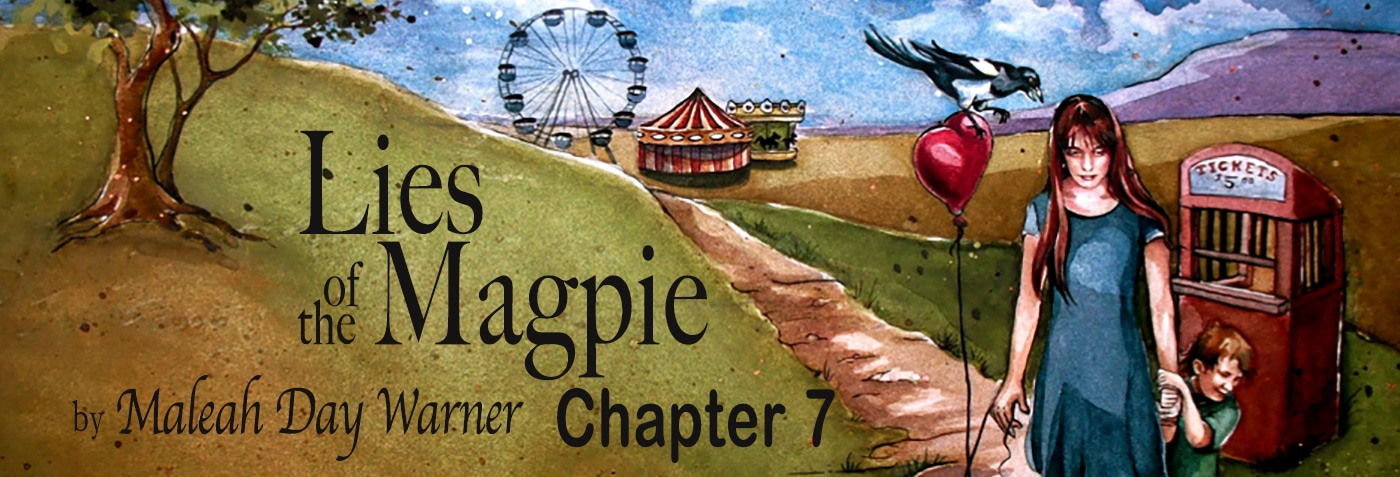Podcast: Play in new window | Download
Subscribe: Apple Podcasts | Google Podcasts | Spotify | Email | RSS | More
Podcast: Play in new window | Download
Subscribe: Apple Podcasts | Google Podcasts | Spotify | Email | RSS | More
Today’s audio selection brings listeners to the end of Part 2 and the beginning of Part 3.
Chapter 30 I Need a Mother Feeling shaky and weak, Maleah gives a presentation to the Chamber of Commerce. Driving home she is dizzy and disoriented and doesn’t have breast milk to feed Jack. Aaron asks why she won’t go to a doctor. Maleah worries that she isn’t really sick enough to go to a doctor and that people think she is a lazy faker.
Chapter 31 Ears to Hear Maleah takes Kate to a new ENT specialist who correctly diagnosis Kate’s hearing issues. Maleah realizes the difference a good doctor can make and determines to schedule an appointment for herself with a new doctor. When her efforts are thwarted, Aaron steps in to comfort her. He has a chance encounter with the doctor and is able to schedule Maleah an appointment.
Podcast: Play in new window | Download
Subscribe: Apple Podcasts | Google Podcasts | Spotify | Email | RSS | More
Ep. 68 What are the three most common mistakes we make regarding mental health issues? Join the podcast to learn how our instinct to respond by ignoring issues, reacting with fear, or trying to force a recovery actually compound mental health issues. Learn simple things to do instead that will encourage health, build relationships, and end the stigma and shame surrounding mental health issues.
Podcast: Play in new window | Download
Subscribe: Apple Podcasts | Google Podcasts | Spotify | Email | RSS | More
When I think back about the year after Kate’s birth, my memories come with the wonder of Dr. Jeckyl and the taint of Mr. Hyde. I was genuinely happy; I wasn’t faking happy. I wasn’t “happy on the surface and sad underneath.” I was happy to the marrow of my bones happy. I experienced joy I didn’t know possible. I had never before known how having children in my life could be so magical.
Danny thrilled me. He was smart, inquisitive, playful, and interactive. He learned quickly, could recognize alphabet letters, learned new sounds daily. He loved dogs and begged to watch Disney’s 101 Dalmatians on VHS every day. We dressed him as a spotted Dalmatian for Halloween.
Kate was the most beautiful baby, strawberry-shaped lips and rose petal cheeks. She was so pink and petite that no one ever mistook her for a boy. She was tiny and strong. She could lift and turn her head a few days after birth and she learned to roll, scoot, and crawl quickly. When she discovered her laugh, it came out hearty and full from deep in the belly, which made her, and the rest of us, laugh harder. Every day she smiled and laughed and flapped her arms the moment Aaron came in the door from work, knowing he would play with and tickle her.
In November, when Kate was six weeks old, nearly all of our family came from Utah for her baby blessing. (A baby blessing is the Mormon version of a Christening, but without the baptism and Godparents.) Even my brother Kevin made the ten-hour drive, which was miraculous because his health seemed to be getting more fragile.
Kevin was eight years older than me, two years older than Annice. He had turned 33 days before Kate’s birth. He had Down’s Syndrome and a hole in his heart (a common complication of Down’s Syndrome which doctors repair today, but not in 1966 when Kevin was born.). His mind was sharp, but his holey heart struggled to pump enough oxygen to his extremities. After the long drive, his fingers and toes were dark purple. When he arrived at my apartment door, he enveloped me with the largeness of his hug and an exuberant Hello!
“Con-grat-u-la-tions,” he pronounced each syllable deliberately.
“Do you want to meet your niece?” I asked.
He sat on the blue loveseat, situated his body, positioned his arms into the shape of a cradle and smiled up at me, ready to receive this marvelous package. I balanced Kate in his arms steadying her head on his crooked elbow.
“She is beee-au . . . bee-au . . . bee-au-ti-ful.” It took three tries to get his favorite word to come out the way he wanted. He leaned down and kissed her forehead.
(Continued on the Audio. Click Play Button Above)
Listen to the rest of Ch. 7. Click Here.
Listen to Ch 6 HERE
Podcast: Play in new window | Download
Subscribe: Apple Podcasts | Google Podcasts | Spotify | Email | RSS | More
Leaning in is a power principle with multiple applications. Today we’re discussing the power of leaning into discomfort in a specific area. I invite you to stay with me to the end and I have an invitation that I think you’ll accept, even if you never thought you would.
Have your ever heard the expression, “Lean into the wind?”
Growing up, my brother and I walked to and from school no matter the weather. Which meant that sometimes we would push forward through fierce storms and arrive at the school building to learn that school was cancelled because buses couldn’t get through the snow. Anyone who has walked in strong wind know that in order to stand up straight in high wind, you can’t just stand up straight, you have to lean forward. You have to lean into the wind. Leaning into the wind means pressing forward in the direction opposite the way the wind blows.
Last summer I did a pioneer handcart reenactment in Wyoming. I don’t know if it has something to do with being near the Continental Divide, but that Wyoming prairie gets a LOT of wind—like blow your tent away in the middle of the night with you in it—kind of wind. And when we were walking and pulling our handcarts, if we wanted to move forward, we had to lean into the wind.
Traditionally lean in has been used in the context of sports to mean “to shift one’s body weight forward or toward someone or something.” In water and snow sports, you can lean into a wave, the wind, a slope, or a turn. You can lean in to a pitch or a throw. You can even lean in to a catch.
The first printed use of the term “leaning into” comes from Hartley Burr Alexander’s 1906 Poetry and the Individual, where Alexander uses the phrase “leaning into the future” in reference to the power of poetry deriving from its “leaning into the future.” And Facebook COO, Sheryl Sandberg, used “lean in” as the title of her 2013 book, a call for women to embrace challenge and risk in the work place and leadership. All uses of the term “lean in” point to the act of moving forward against an opposing force.
Why would we talk about leaning into discomfort? Why would a nice person like myself, ask you to lean into discomfort?
Episode 12 The Power of Imbalance, has been the most downloaded episode to date. (If you haven’t listened, go there next.) I think because it strikes a universal instinct in all of us. We don’t like to feel out of balance or out of control or out of our comfort zone. We don’t like to feel uncomfortable. But, as Shawn my personal trainer taught me, growth happens in the zone of imbalance, in the zone of discomfort. If you never lean into discomfort, you can not grow.
In yoga there is an expression, “Breathe into the stretch.” Yoga instructors emphasize that you shouldn’t push your body to the point of pain, but you should take your body to the point of discomfort, then breathe into that discomfort. Yoga teaches that rather than resisting what feels uncomfortable to move towards it, and in this way your muscles grow. This is opposite our instinct. Our knee-jerk reaction is to move away, to back away, to shy away, or to straight out run away from any discomfort. But, someone the act of leaning into the discomfort, of breathing into it, lessens the discomfort. Keep this in mind as we move to our third point today.
Earlier I said I had an invitation that I thought you would accept, if you can stay with me to the end. I invite you (and me) to lean into our discomfort about discussing mental illness.
When you hear the term “mental illness,” pause to observe your reaction. Do you feel a jolt of resistance? Maybe you really don’t want to hear about it or discuss it. Maybe you feel a strong urge to change the subject or leave the conversation. That’s okay. Whatever reaction you have is okay. I am NOT asking you to change your reaction. I am NOT judging your reaction or saying it is wrong or saying you need to have a different reaction. Not at all. I am simply inviting you to OBSERVE your reaction, your thoughts and feelings, and instead of resisting them, moving away, 0r running away, I am inviting you sit with your discomfort and see what you can learn about yourself. This is an invitation to lean into your emotions. And remember to breathe.
I am assuming that most, if not all of us, have what I would call an averse reaction to hearing the term mental illness. There might be some extremely enlightened yogis and gurus in the world who have no reaction, but most words aren’t neutral. Any word we come in contact with triggers some kind of thought in our brain, which triggers a related emotion. And most of you grew up in the same society I did, with the same social conditioning about mental illness.
And where did that conditioning come from? Movies, stories, experiences.
Did you know that the month of May is National Mental Health Awareness Month and has been since 1949. Congratulations. We are celebrating 70 years of Mental Health Awareness, and you didn’t even know it. I didn’t until this year. Now, think about our social relationship with Mental Illness 70 years ago, 40 years ago, 20 years ago, 10 years ago, (that’s when I was seeing doctors and getting confusing, conflicting, and unsatisfactory explanations about what was going on in my brain), to this year 2019. Good news. There have been a lot of positive changes in diagnosis, treatment and understanding of mental illness, largely due to development in brain science. I feel optimistic and excited that we will continue to progress forward, AS LONG AS and to the extent that we allow ourselves to LEAN INTO the discomfort of entering conversations and getting educated about Mental Illness.
What if all mental illness was simply misunderstood and misdiagnosed physical illness?
In past years, mental asylums were filled with people merely suffering from asthma, hypoglycemia, or diabetes. One of the most compelling stories to prove the negative consequences of misdiagnosing a physical disease as a mental illness is the story of Susannah Cahalan retold in the book (and Netflix Movie) Brain on Fire.
At age 21, Susannah worked as a writer for The New York Post. Out of the blue she began to experience hallucinations and hypersensitivity to annoying noises. Coworkers notice her strange behavior. Her parent take her to a doctor, who says that Susannah has probably been partying too much, working too hard and not getting enough sleep. Later, Susannah has a seizure and her parents take her to the emergency room where doctors prescribe anti-psychotic medication. While in the hospital, Susannah goes catatonic and doctors want to move her to a more permanent psychiatric unit where she will be treated for mental illness.
Dr. Souhel Najjar is asked to help investigate her case. Najjar has Susannah draw a clock. She draws it with all of the numbers (1–12) on the right side of the clock, leading Dr. Najjar to believe that the right hemisphere of her brain is swollen and inflamed. Najjar has her undergo a brain biopsy in order to take cells from her brain for diagnosis. It is found that Susannah has anti-NMDA receptor encephalitis, an autoimmune disease where swelling is caused by antibodies. Dr. Najjar describes it to her parents as her “brain is on fire.” Dr. Najjar prescribes her a treatment, which leads to a slow, but full recovery of her cognitive abilities.
Here is an example of a regular girl nearly locked away for life in a psychiatric ward to be medicated with anti-psychotics that would only make her worse because they wouldn’t treat the root issue. Thankfully, one doctor stepped in. One doctor leaned in and fought for her.
So, what if all cases of “mental illness” are really physical issues we don’t yet understand or haven’t correctly diagnosed?
A person acting strangely does not mean they are mentally ill. What is the WHY? behind the strange behavior? What is happening in the body and brain to cause the unusual behavior? I’m excited for more progress to be made in brain scan technology for these neuro-diagnostic tools to become more available. This is why I want to change the term from mental illness to brain illness in order to emphasize the physical brain issue rather than the stigma of character weakness.
In coming months, we will have increased opportunities to lean into discussions about mental health. This is why I extend the invitation to resist shying away from these important conversations and to lean into our socially-programmed discomfort. A lot of people and organizations are working to shorten the distance between current misdiagnosis and misunderstanding and future effective diagnosis and treatment. In fact Oprah Winfrey and Prince Harry have teamed up to release a docuseries on mental health. In April CNN reported that the multi-part documentary series, which will air on the Apple TV platform in 2020, was co-created and produced by the Duke of Sussex and Winfrey.
Prince Harry said, “I truly believe that good mental health—mental fitness—is the key to powerful leadership, productive communities and a purpose-driven self.”
Winfrey added, “Our hope is that it will have an impact on reducing the stigma and allowing people to know that they are not alone, allowing people to speak up about it and being able to identify it for themselves and in their friends. We want to blow the stigma out of the water.”
What do you think? Are you willing to take on today’s invitation? The invitation is simply this: when you someone mention “mental illness” or “mental health,” pause and observe your initial reaction. Notice if your instinct is to move away, to shut down, to change the channel. Notice if you instinctually want to move away because you feel uncomfortable. Then, instead of moving away, I invite you to LEAN INTO DISCOMFORT. Listen to the conversation, stay on the channel, keep engaged. Breathe. discomfort. Open your heart and mind and be willing to learn and to see a new perspective.



